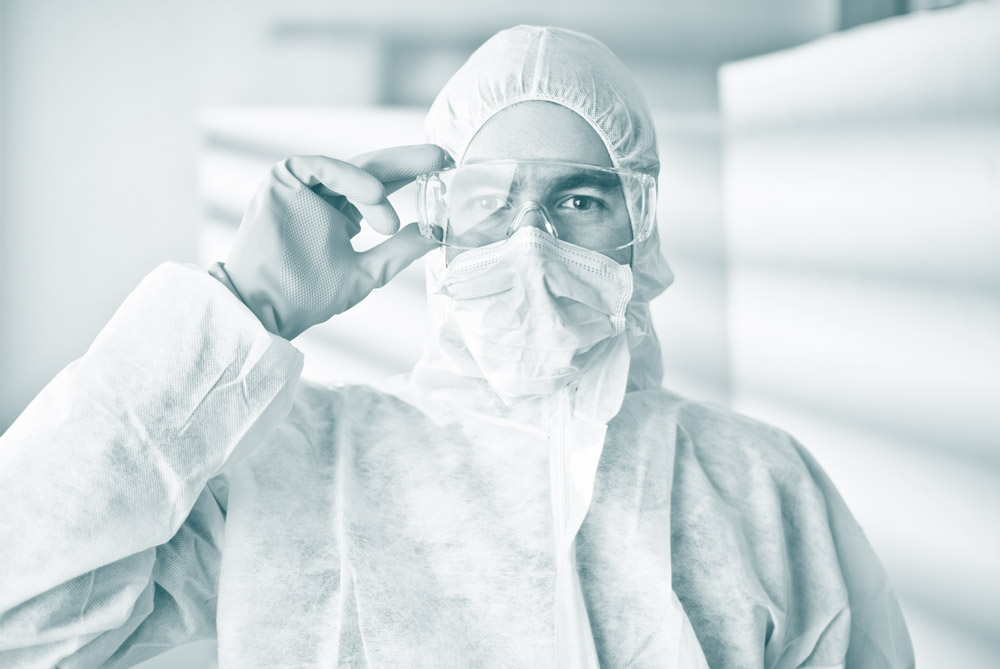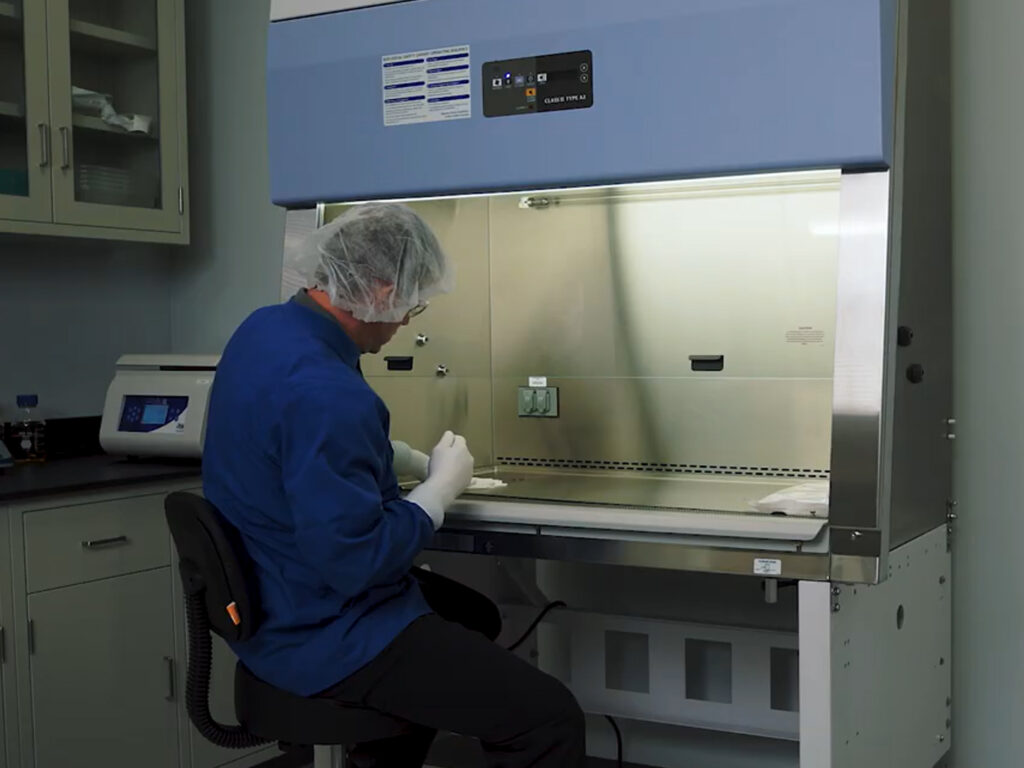Cleaning & Disinfection, Knowledge Base
Considerations for Cleaning a Laminar Airflow Hood
What exactly is a Laminar Airflow Hood?
A Laminar Airflow Hood, also known as a Laminar Flow Hood, is a containment system used in laboratories to protect workers, materials, and the environment from contamination and exposure to hazardous substances. The hood uses filters to remove bacteria, fungi, dust, and other particulates, creating a clean environment. The filtered air flows toward the worker in a smooth, non-turbulent manner. The hood is enclosed on all sides except the front and maintains positive air pressure to prevent contamination. Laminar airflow hoods are categorized into three classes based on industry requirements: Class I, Class II, and Class III.
Class I laminar flow hoods provide adequate protection for personnel and the external environment but do not offer high protection for materials or cultures within the hood. On the other hand, Class II laminar flow hoods provide a sterile environment and are suitable for applications involving BSL-1, 2, and 3 materials. They protect against certain fumes, gases, and hazardous materials. Class III laminar flow hoods are the highest level of protection available. They are designed to provide the most security and are required for applications involving BSL-4 materials and other dangerous human pathogens. They protect against potentially infectious substances.
In laboratories, cross-contamination is a serious concern. Regular cleaning of laminar flow hoods is necessary to prevent it. These hoods are designed to be a controlled environment, so understanding how to keep them clean is crucial. Whether you have a vertical or horizontal laminar flow hood, it is essential to clean it regularly to maintain a proper environment.
Cleaning a Laminar Flow Hood
Cleaning should be done using a specific process, and it is essential to note that the HEPA filter should be replaced according to the manufacturer’s instructions. The guide below will provide the best cleaning practices for maintaining laminar flow hood hygiene. Proper operator behavior in and around the laminar flow hood is essential to avoid unnecessary contamination. Cleanroom Behavior Tips – Top Five.
Proper Cleanroom Cleaning Supplies
Be sure to collect the required supplies before entering the cleanroom environment and follow the necessary procedures.
- Personal protective equipment (PPE) will be a prerequisite. The equipment includes gloves, eye protection, a hair net, and a face mask. A respirator will be required if the lab or manufacturer works with toxic fumes. Ensure you wear a lab gown and full-coverage shoes with shoe covers.
- Cleanroom-Grade Wipes – Laundered polyester wipes, microfiber wipes, nonwoven cleanroom wipers, or sterile wipes may be used and disposed of immediately afterward. Never reuse wipes, as this can increase the risk of contamination. These items are kept inside the cabinet without exiting the work area during cleaning. Berkshire provides lint-free cleanroom wipes that are suitable for your industry.
- Disinfectant, Ethanol, or Alcohol Agents – 70% ethanol or 70% alcohol wipes or sprays will likely be required to remove contaminants. A rotation of Disinfectants, Bactericides, Fungicides, Virucides, and Sporicides may also be required as specified by the hood manufacturer. For example, follow Flow Science, Air Clean Systems, and NuAire recommended cleaning guidelines.
Gowning Donning Preparation
To maintain cleanliness in the cleanroom, it is necessary to remove all personal outer garments, cosmetics, and jewelry from hands, wrists, or any visible body parts before entering. Moreover, individuals with irritated or infected skin, such as rashes, abrasions, cuts, sunburn, weeping sores, or active respiratory infections, produce more particles and must not be allowed inside the cleanroom. Put on your PPE in the following recommended order:
How to Clean a Laminar Airflow Hood
Never spray disinfectant directly onto the HEPA filter or touch the filter.
Assess the hood for any spills or contamination. If found, spray the wipe with disinfectant and mop up the surface.
For the cleaning, take a wipe and fold it into halves or quarters. There are slight differences in the cleaning process depending on whether you have a vertical or horizontal hood. What is the best way to wipe the surface?
- Wipe gloves before wiping surfaces, then discard the wiper.
- In linear strokes whenever possible.
- From known clean areas to known dirty areas.
- From dry areas to wet areas.
- Using a clean wiper surface for each wiping stroke.
When cleaning a Vertical Laminar Flow Hood, begin by taking the wipe and spraying disinfectant onto the wipe. Using the wipe, clean the interior back of the hood using linear strokes. Do not clean in a circular motion, as this can risk contamination.
Continue using a clean side of the wipe for each stroke or a new wipe to clean the side walls, followed by the work surface of the hood. When wiping the work surface, start at the back and sweep in right-to-left linear movements, working forward. Each pass should overlap the last by around 50%.
When cleaning a Horizontal Laminar Flow Hood, begin with spraying a clean wipe, taking care to wipe hard-to-reach sections by wiping the ceiling of the flow hood. Take a fresh side of the wipe or a new one. Continue with the sidewalls and the work surface using right-to-left, back-and-forth linear movements that overlap by 50%.
Post-Cleaning Sterilization, some laminar airflow hoods may have Germicidal lamps for sterilization. Always follow the manufacturer’s guidelines for use and ensure no contact with the hood during any sterilization procedure. When cleaning is complete, dispose of wipes, gloves, and gowns in the proper waste container. Always remember to wash your hands afterward.
Keeping Your Laminar Airflow Hood Clean – Maintaining a clean or sterile laminar airflow hood is essential to avoid cross-contamination. Following a strict cleaning process and the manufacturer’s recommendations, you can keep your air flow hood hygienic. Check out our full range of cleanroom supplies to ensure your laboratory equipment stays in peak operating condition.
The information supplied in this article is for guidance only. Not all Laminar Airflow Hoods use the same procedures. Follow your specific manufacturer or company procedural manual before this guide.





















HAVE AN IDEA FOR CONTENT?
We are always looking for ideas and topics to write about.
Contact Us